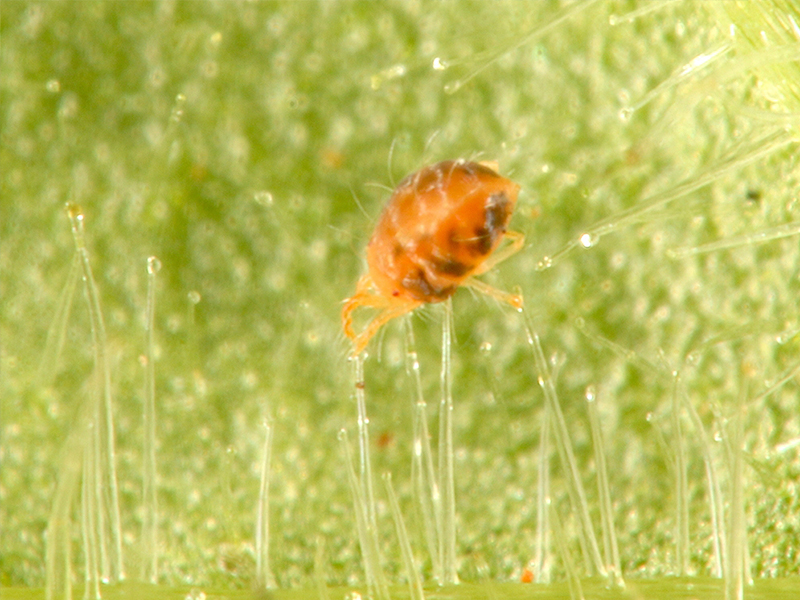African nightshade lures spider mites to a dead-end
A species of the African nightshade, an important indigenous vegetable in Africa, appears to have inherited from its ancestors a unique ability to defend itself against one of its major pests, the tomato red spider mite, according to a recent study by the International Centre of Insect Physiology and Ecology (icipe).
In a paper published in the current issue of the PLoS ONE journal, the icipe researchers report that a species of African nightshade has over time developed a sweet smelling mixture of compounds in its leaves that is capable of fooling spider mites by attracting them to the plant.
“We found that when the mites reach the leaf’s surface, the “small hairs” on the leaf, known scientifically as trichomes, trap the pests, hindering their further movement. Additionally, the disturbance caused by the mites on the leaf surface causes the glandular tips, or the “succulent lobes”, of these hairs, to crack. The cracked lobes then release secretions that contain foul smelling chemicals that prevent the pests from laying eggs, thereby breaking their reproduction cycle,” explains Dr Lucy Kananu, lead author of the study.

“This is a fascinating discovery, which advances knowledge on the evolutionary arms race between plants and pests. Past studies have demonstrated that while plants use various defense systems against pest attack, pests can overcome these defenses, for instance by avoiding or suppressing them. Our findings show a distinctive defense strategy in a plant that is based on opposing roles, with the leaf fragrance acting as an attractant, while the stinking odors from the cracked trichome lobes defend the plant against certain insect behaviours, such as egg laying of the attacking pests. In effect the pest is lured to a ‘dead-end’ in its life cycle,” she adds.
The findings by icipe are also particularly important given the growing attention on the vital role that indigenous vegetables can play in improving the nutritional security of many African households. African nightshade (Solanaceae) comprise closely related leafy species which are grouped together in a complex known as Solanum nigrum. Part of this group includes S. sarrachoides, S. scabrum and S. villosum, which are consumed widely in parts of eastern and southern Africa. In Kenya, African nightshades are known, in their respective local languages as mnavu (Kiswahili), managu (Kikuyu), namaska (Luhya), and osuga (Luo), and are an excellent source of protein, iron, vitamin A, iodine and zinc.

Known scientifically as Tetranychus evansi, the tomato spider mite originates from Brazil and was accidentally introduced into Africa some 20 years ago. The pest causes serious damage, significantly hindering the production of African nightshade and other crops that are members of the Solanaceae family (tomato, potato, eggplant, tobacco and wild plants and weeds like black nightshade, bitter apple and wild gooseberry).
“Our goal is to investigate the extent of the defense strategy in this specific African nightshade species and others closely related to it, and to establish its application in the management of spider mites,” concludes Prof. Baldwyn Torto who supervised the study.
Notes for Editors
Publication: Murungi L.K., Kirwa H., Salifu D. and Torto B. (2016) Opposing Roles of Foliar and Glandular Trichome Volatile Components in Cultivated Nightshade Interaction with a Specialist Herbivore PLoS ONE Available at: http://journals.plos.org/plosone/article?id=10.1371%2Fjournal.pone.0160383
Funding: We gratefully acknowledge the financial support for this research by the following organizations and agencies: the International Foundation for Science (www.ifs.se) through a grant (no. F/5201-1), to Lucy Kananu Murungi; UK’s Department for International Development (DFID); Swedish International Development Cooperation Agency (Sida); the Swiss Agency for Development and Cooperation (SDC) and the Kenyan Government. The views expressed herein do not necessarily reflect the official opinion of the donors.
Acknowledgement: The researchers are grateful to the World Vegetable Centre (AVRDC), Arusha, Tanzania and the National Gene Bank of Kenya for providing the seeds of African nightshades.
Corresponding author: Prof. Baldwyn Torto, Email: btorto@icipe.org, Tel: +254 20 8632000
Media Contacts: Dr Liz Ng’ang’a, Communications Unit, icipe, lnganga@icipe.org
The International Centre of Insect Physiology and Ecology (www.icipe.org), headquartered in Nairobi, Kenya, is a world-class research centre whose mission is to contribute towards poverty reduction, food security, better health and environmental protection across Africa and the developing world, by enhancing the capacity of researchers and communities to produce and utilise insect sciences.

